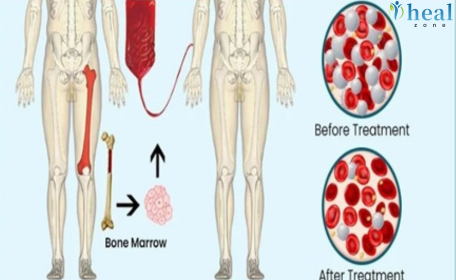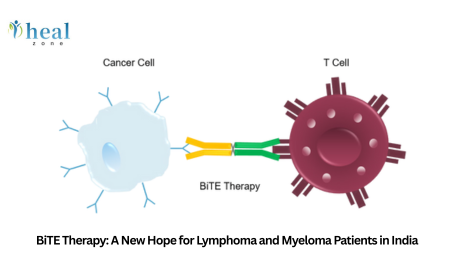What is Cemented Total Hip Replacement Surgery?
Cemented Total Hip Replacement is a surgical procedure where the damaged components of the hip joint are removed and replaced with artificial implants fixed using bone cement. This cement acts as a grout, ensuring immediate stability by bonding the implant to the natural bone.
This procedure is often preferred in:
- Elderly patients with low bone density
- Patients with rheumatoid arthritis or osteoarthritis
- Individuals with fractures or injuries affecting the hip joint
It is known for quicker recovery, reduced pain, and restoration of function in everyday activities such as walking, standing, or climbing stairs.
Who Needs a Cemented Total Hip Replacement?
A Cemented THR is typically advised for patients who suffer from:
- Advanced osteoarthritis or rheumatoid arthritis
- Hip joint fractures that cannot be repaired
- Avascular necrosis (loss of bone tissue due to lack of blood)
- Congenital or developmental hip disorders
- Severe stiffness, pain, and reduced mobility affecting quality of life
It is especially effective for patients who are:
- Aged 60 and above
- Less physically active
- In need of quick post-surgery weight-bearing and mobility
The decision to opt for cemented over uncemented implants depends on the patient’s bone quality and overall health status.
What are the Different Types of Hip Replacement Procedures?
There are several types of hip replacement procedures, and choosing the right one depends on the patient's age, activity level, and bone structure. The main types include:
- Cemented Total Hip Replacement
– Uses bone cement to anchor the artificial joint. Ideal for older adults with softer bones. - Uncemented (Press-fit) Total Hip Replacement
– Relies on bone growth into the implant. Preferred for younger, active individuals. - Hybrid Hip Replacement
– Combines cemented and uncemented components for customized solutions. - Partial Hip Replacement (Hemiarthroplasty)
– Replaces only the femoral head. Usually used in cases of fracture. - Bilateral Hip Replacement
– Both hips are replaced in a single surgical session.
For international patients visiting India, cemented THR is often chosen due to its affordability, effectiveness in older adults, and lower complication rates.
What is the Step-by-Step Treatment Protocol for Cemented Total Hip Replacement in India?
The treatment protocol for international patients is designed for comfort, efficiency, and safety. Here's a standard pathway:
1. Pre-Arrival Consultation (Online or via Medical Tourism Coordinator)
- Sharing of medical history, X-rays, or MRI
- Pre-surgical evaluation by specialists
2. Arrival and Initial Evaluation
- Physical examination
- Diagnostic tests: blood work, ECG, X-ray, MRI if needed
- Anaesthesiology clearance
3. Surgical Planning and Admission
- Personalized surgical plan
- Pre-surgery physiotherapy instructions
- Admission to hospital a day before surgery
4. Surgical Procedure (Duration: 1.5 to 2 hours)
- General or spinal anaesthesia
- Removal of damaged joint parts
- Fixation of implants using bone cement
- Suturing and dressing of surgical site
5. Postoperative Care (Hospital Stay: 4–7 Days)
- Pain management and antibiotics
- Initiation of physiotherapy on Day 1 or 2
- Monitoring for infection, clotting, or dislocation
6. Discharge and Recovery (Rehabilitation Period: 4–6 Weeks)
- Discharge with instructions and medications
- Regular physiotherapy for mobility
- Virtual follow-up after travel (teleconsultation)
India’s structured treatment timeline allows most international patients to complete treatment within 2 to 3 weeks, including pre-op, surgery, and post-op care.
Why Choose India for Cemented Total Hip Replacement Surgery?
India has become a global hub for orthopedic procedures like Cemented Total Hip Replacement, attracting thousands of international patients annually. Here are key reasons why India is a preferred destination:
- World-Class Infrastructure: Hospitals are equipped with advanced surgical technology and adhere to international standards such as NABH and JCI.
- Highly Skilled Orthopedic Surgeons: Many Indian specialists are trained in the US, UK, and Europe with decades of clinical experience.
- Affordability: The cost in India is up to 70–80% lower than Western countries without compromising quality.
- Short Waiting Times: Unlike countries with long surgical queues, Indian hospitals offer near-instant availability for international patients.
- English-Speaking Medical Staff: Most healthcare professionals speak fluent English, ensuring clear communication and comfort.
- Integrated Medical Tourism Services: From airport pickup to post-op care, patients receive concierge-style services.
Choosing India offers a blend of medical excellence, hospitality, and economic value.
Why Choose Healzone for Your Hip Surgery in India?
Healzone is a trusted facilitator for medical tourism in India, offering complete end-to-end support tailored to international patients. Here’s why Healzone stands out:
- Personalized Treatment Plans: Healzone matches you with the most suitable hospital and surgeon based on your medical needs and preferences.
- Transparent Pricing: Clear and upfront cost estimates with no hidden charges.
- Visa & Travel Assistance: From medical visa guidance to airport transfers, Healzone takes care of all logistics.
- Dedicated Case Managers: Each patient gets a personal coordinator who manages appointments, interpreters, and rehabilitation schedules.
- Post-Treatment Care Coordination: Healzone stays in touch even after you return home, ensuring follow-ups and continuity of care.
By choosing Healzone, international patients benefit from a seamless, stress-free, and highly efficient medical journey in India.
What Types of Implants and Devices Are Used for Cemented Hip Replacement in India?
In a cemented total hip replacement, two major components are implanted:
- Femoral Component (Stem) – Inserted into the femur (thigh bone) and fixed using surgical-grade bone cement.
- Acetabular Component (Cup) – Placed in the hip socket, often made of polyethylene or ceramic materials.
Types of materials used:
- Metal-on-Polyethylene (MoP): Durable and commonly used for elderly patients.
- Ceramic-on-Polyethylene: Offers smooth articulation with low wear rate.
- Ceramic-on-Ceramic: More costly but highly biocompatible with minimal wear.
Implant brands and technology: India uses internationally recognized implants from Europe, the USA, and domestic high-quality manufacturers, all compliant with CE and FDA certifications. These devices are designed for longevity (15–25 years lifespan) and biocompatibility.
What is the Detailed Cost Breakdown for Cemented Hip Replacement in India?
The cost of Cemented THR in India typically ranges between $5,000 to $10,000 USD, depending on the city, hospital tier, and implant quality. Below is a detailed cost split:
|
Component |
Estimated Cost (USD) |
|
Pre-surgical Consultation |
$50 – $100 |
|
Diagnostic Imaging (X-Ray, MRI) |
$150 – $300 |
|
Lab Tests & Pre-Op Clearance |
$100 – $200 |
|
Surgery Charges |
$2,000 – $3,500 |
|
Implant Cost (Imported or Local) |
$1,000 – $2,500 |
|
Hospital Stay (5–7 Days) |
$500 – $1,200 |
|
Anaesthesia & OT Charges |
$400 – $800 |
|
Post-Op Physiotherapy (Inpatient) |
$200 – $400 |
|
Medications & Consumables |
$300 – $500 |
|
Follow-Up & Teleconsultation |
Included / $50 Optional |
Total Approximate Range: $5,000 – $10,000 USD
Patients opting for premium implants or private room upgrades may incur higher costs, while budget packages are available for basic care with high-quality outcomes.
What is the Procedure Type and Duration of Recovery for Cemented Hip Replacement?
Cemented Total Hip Replacement is classified as a major elective orthopedic procedure that typically requires:
- Hospitalization: 4–7 days
- Surgical Time: 1.5 to 2 hours
- Anesthesia: Spinal or general anesthesia
- Weight-bearing: Allowed as early as 1–2 days post-surgery
Recovery Timeline:
|
Timeframe |
Recovery Milestones |
|
Day 1–3 |
Begin walking with walker/crutches, pain control begins |
|
Week 1–2 |
Improved mobility, staples/sutures removed |
|
Week 3–6 |
Resumption of daily activities with mild physiotherapy |
|
Month 2–3 |
Return to work (desk jobs), improved joint movement |
|
Month 6+ |
Full mobility and long-term strength building |
Most international patients are medically fit to fly back home within 2–3 weeks, provided they continue physiotherapy at home or under Healzone’s remote guidance.
What are the Benefits of Cemented Hip Replacement Surgery?
Cemented hip replacement surgery offers a variety of physical, emotional, and economic benefits, especially for aging patients with weakened bone structures.
Key Advantages:
- Immediate Joint Stability: Cement provides instant fixation, allowing early mobilization.
- Pain Relief: Eliminates chronic joint pain caused by arthritis or injury.
- Improved Mobility: Restores ability to walk, climb stairs, and perform routine tasks.
- Enhanced Quality of Life: Reduces dependence on pain medications or walking aids.
- Affordable Long-Term Solution: One-time surgery with implants lasting 15–25 years.
- Quicker Recovery in Elderly Patients: Especially beneficial for those with osteoporosis.
When performed in India, these advantages are amplified by shorter waiting times, expert care, and cost-efficiency.
Are There Any Risks or Complications Involved in Cemented Hip Replacement?
Like all surgeries, Cemented Total Hip Replacement comes with potential risks, though they are minimal in skilled hands and with proper preoperative screening.
Possible Risks Include:
- Infection at the surgical site (rare with sterilized environments)
- Blood clots (deep vein thrombosis)
- Hip dislocation or implant loosening over time
- Allergic reactions to bone cement (very rare)
- Leg length discrepancy (correctable with custom implants)
- General anesthesia-related complications (minimized by cardiac clearance)
Prevention Measures in India:
- Use of advanced OT filtration and sterile techniques
- Pre-surgical antibiotics and post-op monitoring
- DVT prophylaxis and early mobilization
- Comprehensive patient screening and surgical planning
When international patients choose accredited hospitals via Healzone, complication rates remain as low as those in Western countries.
What Aftercare is Required Following a Cemented Hip Replacement?
Proper aftercare ensures faster healing, improved joint function, and long-term implant success. Here's a structured aftercare protocol followed in India:
1. Physiotherapy:
- Begins within 24–48 hours of surgery
- Strengthens surrounding muscles
- Continues for 4–6 weeks (in-person or virtual)
2. Medication Management:
- Pain relievers and anti-inflammatory drugs
- Antibiotics for infection prevention
- Blood thinners for clot prevention
3. Wound Care:
- Regular dressing changes
- Stitches/staples removal after 10–14 days
- Monitoring for redness, swelling, or discharge
4. Lifestyle Guidance:
- Avoid twisting or bending past 90 degrees
- Sleep with a pillow between legs initially
- Use assistive devices for first few weeks
5. Follow-up and Monitoring:
- In-person before discharge
- Virtual follow-up (telemedicine) with Healzone coordinators
- X-rays at 6 weeks and 6 months to monitor implant position
India's aftercare model blends modern rehab protocols with personalized care, ensuring long-term patient satisfaction.
Why India is the Best Choice for Cemented Hip Replacement for International Patients?
India offers the perfect combination of clinical excellence, cost-effectiveness, and compassionate care for international patients seeking Cemented Total Hip Replacement.
Top Reasons to Choose India:
- Internationally trained orthopedic surgeons
- Accredited hospitals with advanced infrastructure
- Comprehensive treatment packages at $5,000–$10,000 USD
- Seamless travel support and personalized care through Healzone
- Short hospital stays and fast-track recovery plans
- Transparent billing, no hidden charges
Whether you're an elderly patient needing mobility, or a caregiver seeking value-for-money surgery options, India stands out as the most reliable and budget-friendly orthopedic destination.
Cemented Total Hip Replacement is a life-enhancing surgery, and getting it done in India not only ensures world-class medical outcomes but also reduces the financial and logistical burden. Healzone acts as your trusted partner every step of the way — from travel planning to rehabilitation.
If you’re considering hip replacement abroad, India offers unmatched value, clinical outcomes, and recovery support tailored to international patients' expectations














